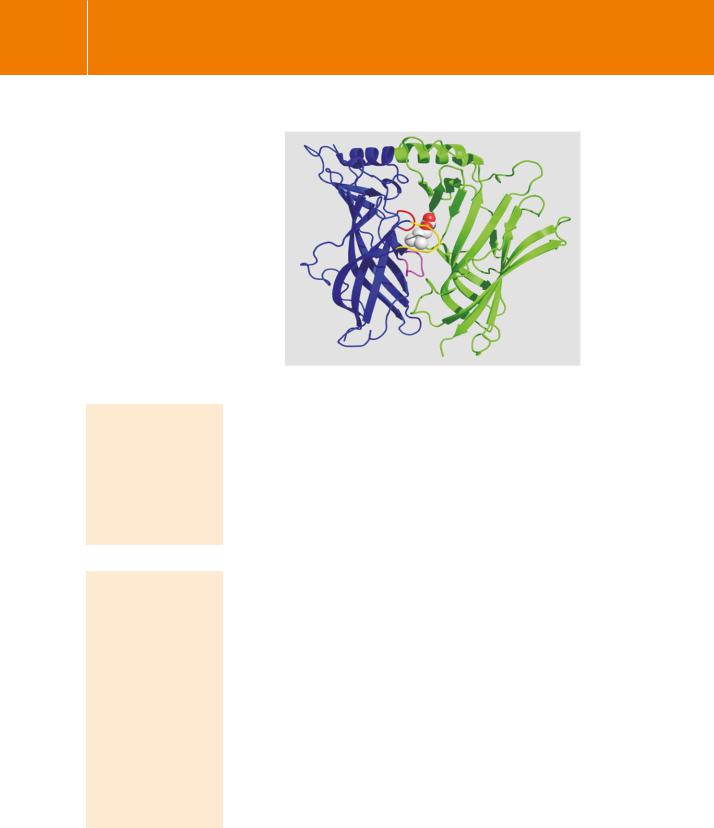
- •Adrenaline (again)
- •Adrenergic receptor agonists and antagonists
- •Acetylcholine receptors
- •Acetylcholine
- •Cholinergic receptor subtypes
- •Nicotinic receptors
- •Muscarinic receptors
- •Nicotinic receptors are ion channels
- •Architecture of the nicotinic receptor
- •Other ligand-gated ion channels
- •The 7TM superfamily of G-protein-linked receptors
- •Categories of 7TM receptor
- •Receptor diversity: variation and specialization
- •Binding of low-molecular-mass ligands
- •Calcium sensors and metabotropic receptors
- •Proteinase-activated receptors (PARs)
- •The adhesion receptor subfamily
- •Frizzled
- •Receptor–ligand interaction and receptor activation
- •A two-state equilibrium description of receptor activation
- •Receptor dimerization
- •Transmitting signals into cells
- •The receptor and the effector: one and the same or separate entities?
- •Mixing and matching receptors and effectors
- •Intracellular 7TM receptor domains and signal transmission
- •Adrenaline (yet again)
- •References

Signal Transduction
Fig 3.10 Partial structure of
Lymnea stagnalis acetylcholinebinding protein showing bound ligand. Two of the five -subunits are shown (blue and green) with a molecule of carbamylcholine (spheres). The B-loop (red), C-loop (yellow), and A-loop (magenta) are indicated.(1ux2.24).
The term metabotropic is used to distinguish these G-protein-linked receptors for glutamate, GABA, etc. from the ionotropic receptors that possess integral ion channels operated by the same ligands.
Of course things are never as simple as one might wish. The direction of the ion flux must depend
on the intracellular concentration of Cl but in the neurons of the hypothalamic
suprachiasmic nucleus (SCN) this appears to vary diurnally, being higher during the daylight hours, probably because of the operation of a cyclically modulated ion pump.25 Depending on the time of day, the consequence
Receptor desensitization
When a receptor has been exposed to acetylcholine for prolonged periods it becomes unresponsive to further stimulation. This phenomenon, known as desensitization, is regulated by the , , and subunits. The extended intracellular loops linking M3 and M4 of each subunit contain sites for phosphorylation by protein kinases A and C. The longer acetylcholine is bound to the -subunits, seconds rather than milliseconds, the greater the extent of phosphorylation. This explains why the potent inhibitors of
acetylcholine esterase, such as diisopropyl fluorophosphate (DFP) and sarin, are so toxic. By preventing the hydrolysis of acetylcholine, the stimulus is initially prolonged, but when it does eventually diffuse away and the channels have closed, the extensive phosphorylation ensures that they cannot then be reopened. The receptors are said to be desensitized.
Other ligand-gated ion channels
The ion channels that are activated by extracellular ligands may be divided into three superfamilies: Cys-loop receptors, glutamate-activated cationic channels, and ATP-gated channels. Members of the Cys-loop superfamily are pentameric and in addition to the nicotinic receptors, include receptors for the amino acid neurotransmitters GABA and glycine. As discussed above, these are Cl channels, present for example on postsynaptic membranes of neurons, and they have an inhibitory effect. When they are open, Cl ions enter the cells, causing a local membrane hyperpolarization. This tends to counteract the effect of an excitatory neurotransmitter by decreasing the
probability that the postsynaptic cell will depolarize beyond the threshold for an action potential.
54
